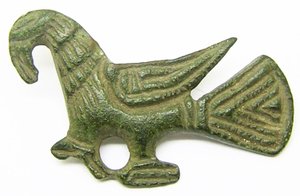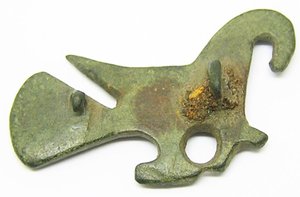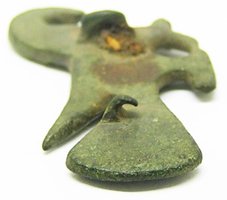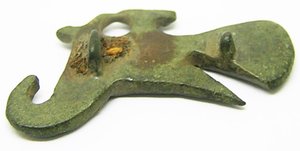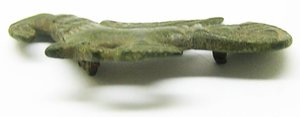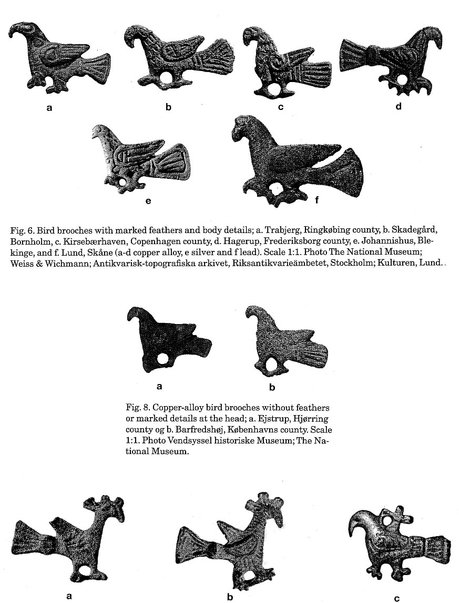Scandinavian late viking bird brooch
Bird brooches from the late(r) Viking era have been found in Scandinavia as wel in areas occupied and inhabited by the vikings and Norsemen within England and Anglo-Scandinavian and Anglo-Saxon context. These so called bird shaped brooches can be addressed to the 11th and even early 12th century. Stylistically the brooch here cannot be categorized towards an distinct 'Viking style' as the late Urnes style, although some types of other bird shaped brooches shows us connections to the Ringerike and Urnes style.. The decoration and form of the bird on the brooch here is more under the influence of developing Romanesque outings spreading its way from the Continent in Scandinavian art. See for example the style of a bird, depicted on the right corner next to the door portal of Rimsø Kirke, Jylland. The church dates back from 1150 A.D.
The brooch is intact with a wonderful olive-green patina. The iron pin on the back has detoriated in the ground, only traces are remaing. The - bronze - brooch measures 36 mm x 19 mm x 22 mm and weighs 5.86 grams and was found near Dereham. Norfolk, England in 2014. It is very well preserved.
Similar brooches are known from Denmark and an example of Skadegard, Bornholm - see figure 6 b on the attached page beneath - shows us a very similar form and decoration. So far England is the only area outside Scandinavia where bird brooches similar to those discovered in Denmark have been found. The archeaological finds indicate close contacts between England and Denmark in the first half of the 11th century. Anne Pedersen is suggesting that Byzantium art may be a source of inspiration for these specific type of brooches as is evident from the Danish coinage of the 11th century that direct or indirect influence from Byzanthium played an important role. The clearest link is to western Europe, an area important for the development of Danish society and the Christian church during the Viking Age. The geographical distribution of the brooches in Denmark points westwards, and an arlier brooch traditiin is evident in Germany, France and England.
The bird-shaped brooches of the 11th century represented a new type of ornament and it is likely that they served not only practical and decorative purposes but were an ornament with symbolic value. Whether the brooches represent birds of prey, doves aor another bird - a raven ? - is difficult to determine, but birds as well as other animals played an important role in Christianity. The brooches appear in the 11th century when the Christian church was advancing in Denmark. Bird motifs were common in previous centuries, but it is possible they achieved a new significance in the context of the new religion.
Reference: Pedersen, A., Birds of Prey or Doves. Early Medieval bird-shaped brooches.
Well. I could have been with these stones until after dark, but as my wife wanted to travel on.. well.. I see you again, some day, hogback stones from Gosforth. And if you happen to be there one day, do not forget that monument on the outside...
Further on with the Cumbrian hogbacktour !
In - yes, luckily again in - St. Peter's church in Heysham, there is a truly beautiful hogback stone. The guide told us, it had been studyied by Thor Ewing, a writer, in 2000. in 'Understanding the Heysham hogback' A tenth century sculpted stone monument and its context (link), Thor Ewing tells in detail what he dicovered on the both sides of this hogback stone.
Just being brought in the church as late as the 1970's accompanied with some protest here and there among the church visitors, considered as being a token of old paganism, it had been remarkably nice preserved, and a lot of detail can be seen, still. Truly worthwile a visit.
I had a small debate with the guide in the church if the - zoomorphic, in my opinion - faces on the sides were lions (or hippo's). The guide doubted if the vikings could have known about lions. Well I guess so, concerning the runes on the Ancient Greek lion statue at the Arsenal, Venice. For example. Vikings did travel south..
But when he told me he was doubting the vikings 'discovered' (as the native inhabitants were of course, in the first place) America before Columbus, I decided to rest my case..
One has to know when to start and to end a conversation ..
Just discovered the book in a bookstore written by Geoff Holder - The guide to the mysterious Lake District, I knew there had to be another hogback stone in Lowther, St. Micheal's Church. With a promising image described in the text of 'a naval and a land-based force of shield-bearing vikings above a fish and what might be a coiled sea serpent. On the reverse is a row of female figures with snakes, possibly a representation of the hideous hag Hel'. Wow. If that did not sound as a true pagan promised land ..
Not complaing too much after all we have seen, this visit was the dissapointing one of them all. But if you wife states 'I am happy to have seen them' and I am answering 'Measuring is knowing' and the even more obligate verb 'handling 'if we did not see it at all, we wouldn't have known anything at all of how they were looking' the glass was again half full, at the last day of our journey..
The hogback stone appeared to be just being tolerated within the entrance segment part of the church. As something you never use anymore but you do not throw away - entirely. That sort of feeling emerged when seeing this hogback asylum seekers.. Bed, bath and bread, ás we say in Dutch, but no luxury at all and standing on some outcuts of wood, you would balance the table with at home..
Come on, St. Micheal's Church.. care a bit more of your 'children' !
This hogback stone was moved in the church in 1907. Hogback stones layed partially buried in the churchyard before it was dug up and moved into the church.
The promising depiction of a longship - as certainly can be seen after some studying - see http://vikingminds.co.uk/pages/longship
we have missed !
The stone itself is (157 x 50 x 30 cm) and very worn.
The hogback stones in Cumbria - very diverse in quality, but everyone worth a visit ! Especially on a gloomy day in late October ...
The churches to visit - see photos of resp. St. Andrew's church in Penrith, St. Mary's church in Gosforth, St. Peter's church in Heysham and St. Micheal's church in Lowther.
Did I miss out on another one in Cumbria ? Let me know !
In a next blog I will take you to four - still remaining utterly mysterious- statues 'guarding' the graveyard of St. Andrew's church in Dacre..
For the last blog of October 9th see this link.
References: (as always, links to where the books can be ordered are attached).
Edwards, B.J.N. Vikings in North West England - The artifacts (1998);
Emery, Gordon, CURIOUS CUMBRIA, The Lake District & Beyond: A celebration of Cumbria (2023)
Ewing, T. 'Understanding the Heysham hogback' A tenth century sculpted stone monument and its context ;
Hall, R. Viking Age archaeology in Britain and Ireland (first printed 1990, reprinted with amendments in 1995);
Holder, G. The guide to the mysterious Lake District (2009)
possibly also (as there within the part of Cumbria dealing with Carlisle, the Eden Valley, Barrow-in-Furness, Whitehaven and the west coast is being dealed with)
Holder, G. Paranormal Cumbria (2010)
http://vikingminds.co.uk/pages/longship
